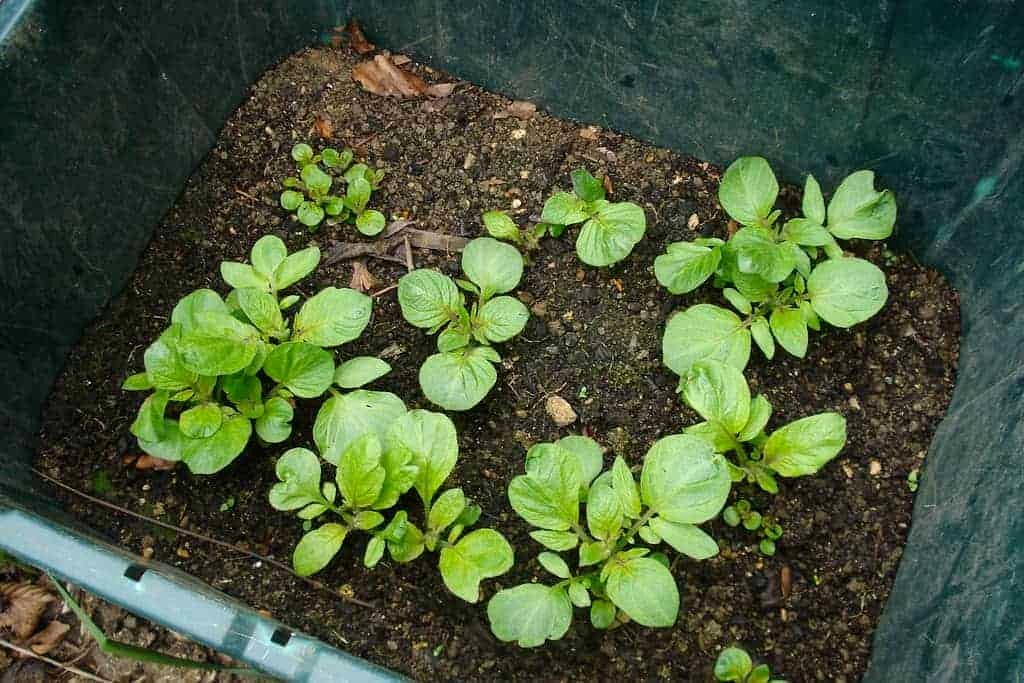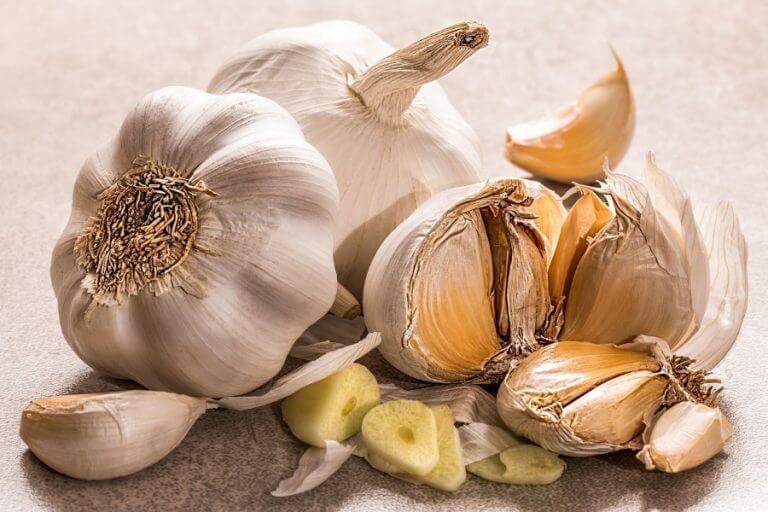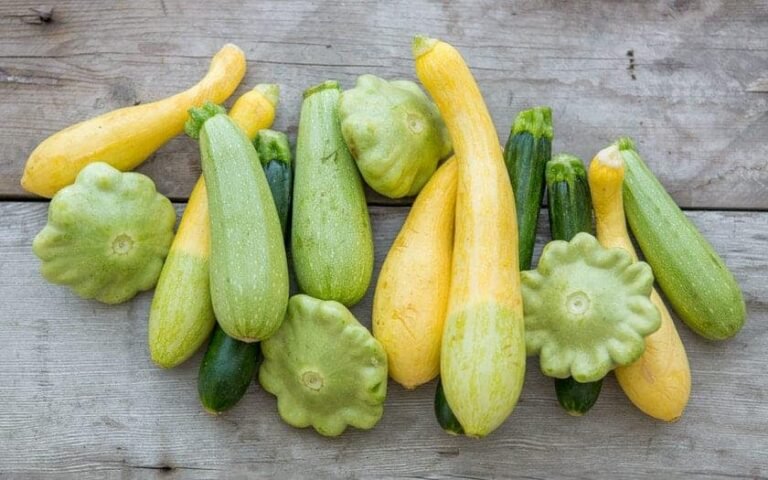How To Grow Potatoes In Containers And Harvest Quality Produce

If you are in search of the best way to grow potatoes in containers and harvest quality produce, this article will show you a simple step-by-step guide on how to do that as a beginner or an expert.
You will understand that learning how to grow potatoes in containers from start to finish to make a quality harvest can be very easy for you to do with this step by step guide.
In this article, you will also learn about potatoes and where they originated from.
Furthermore, you will learn about the uses and health benefits of potatoes.
You will also find some of the diseases of potatoes, how to prevent and/or treat them and general tips on how to care for your potatoes.
If you’re a beginner, I have put together the varieties that will be easy for you to grow.
Let’s get started!
An Overview About Potato Plants
Potato (SOLANUM tuberosum) is an annual plant.
It is from the nightshade family Solanaceae.
Potatoes are grown for their starchy, edible tubers.
It’s a root vegetable native to the Americas.
The potato was believed to have been domesticated by native Americans in multiple locations.
But later, genetic studies traced and confirmed it in southern Peru and Bolivia.
Today, it is a staple food in many parts of the world.
Also, there are now about 5000 different types of potatoes.
The English word potato comes from Spanish patata.
Uses Of Potatoes
- The fleshy part of the potato root is commonly eaten in various forms as a vegetable.
- Industrially, it’s used to make medicines.
- People use potatoes for high blood pressure, indigestion and diabetes.

What Are The Health Benefits Of Potatoes?
Here, we will look at the 8 health benefits of potatoes.
1. Bone Health
Potatoes contain iron, phosphorus, magnesium, zinc and calcium.
These minerals all help the body to build and maintain our strength and bone structure.
Iron and zinc play quite important roles in producing and maturing collagen.
Calcium and phosphorus are both vital in bone structure.
2. Heart Health
The fact that potatoes lack cholesterol means that it’s a great heart health supporter.
Alongside this, the fibre, vitamin C and B6 and potassium all support heart health.
Potatoes also contain significant amounts of fibre.
Fibre helps to lower the total amount of cholesterol in the blood, thereby, reducing the risk of heart disease.
3. Blood Pressure
A low sodium intake is essential for maintaining healthy blood pressure, but increasing potassium intake may be important. Potassium encourages vasodilation or the widening of the blood vessels.
According to the National Health and Nutrition Examination Survey (NHANES), fewer than 2 percent of American adults meet the daily 4,700-milligram recommendation.
Potassium, calcium, and magnesium are all present in the potato. These have been found to decrease blood pressure naturally.
4. Digestion And Regularity
Because potatoes have fibre content, they help to prevent constipation.
They also promote a healthy digestive tract.
5. Weight Management And Satiety
Dietary fibres are commonly recognized as very important factors in weight loss and/or management.
This is simply because they increase satiety, i.e, you get satisfied easily,
They also reduce appetite so that you feel full for longer and will be less likely to consume more calories.
6. Memory Boost
Choline is an essential nutrient that is found in potatoes.
It helps with muscle movement, learning, mood and memory.
7. Skin Support System
Collagen is the skin’s support system.
Vitamin C works as an antioxidant to help prevent damage caused by the sun, pollution, and smoke.
Vitamin C also helps collagen smooth wrinkles and improve overall skin texture.
8. Immunity
Research has found that vitamin C may help reduce the severity and duration of a cold. Potatoes are a good source of vitamin C.
What Are The Conditions Necessary To Grow Potatoes In Containers?
All these conditions need to be met for you to successfully grow potatoes in containers:
1. Grow Potato In Loam Soil
Potatoes grow best in loose, well-drained loam soil.
Heavy clay soil retains too much moisture, making it hard as it dries.
This makes it difficult for the tubers to grow.
2. Potato Grow Best In Cool Temperatures
The ideal soil temperature for growing potatoes is 60 to 70 degrees Fahrenheit (16 to 21 Celsius).
Potatoes are a cool-weather crop, so they prefer cooler temperatures for the growth and development of tubers.
3. Potato Need Full Sunlight
They grow best with at least 6 hours of full and direct sunlight.
This will support the growth of the root.
4. Potato Need A Slightly Acidic PH
The ideal pH for growing potatoes is between 6 and 6.5, which is somewhat acidic.
5. Add Manure To The Soil
To satisfy your soil’s nutrient needs, you can add manure or compost and organic matter to it.
6. Potato Need Water
Planting potatoes in a container will need a steady supply of water.
This is because potatoes are sensitive to drought conditions.
However, be careful not to excessively water the potato plant in the container.
The 3 Main Types Of Potato To Grow
There are three main types of potatoes to grow.
They are named according to when you plant and harvest them.
1. First early or ‘new’ potatoes
They are the earliest crop, in June and July.
They don’t store for long so they are best eaten fresh
2. Second earlies (also called ‘new’ potatoes)
They take a few more weeks to mature and are harvested in July and August.
This variety doesn’t store for long too, so they are also best eaten fresh.
They have a firm, waxy texture and many have an intense flavour.
3. Maincrop potatoes
They take the longest to mature and are harvested from August to October.
These potatoes are used for baking, mashing and roasted.
They can be stored for a few months.
The 5 Best Potato Varieties Beginners Can Easily Grow
- Ambo
- Bambino
- Casablanca
- Charlotte
- Sarpo Una

How To Grow Potatoes In Containers In 6 Easy Steps
Step 1: Soil/ Potting Mix Preparation For Planting Potatoes
To grow your potatoes in containers, you will need a potting mix or soil.
Most people prefer to just buy the potting mix but I prefer to mix my own.
If you are mixing your own too, a good mix consists of ⅓ good quality finished compost, ⅓ vermiculite or perlite, and ⅓ coconut coir (husks) or peat moss.
Step 2: Potato Seed Preparation
Potatoes are generally grown from seed potatoes.
These seed potatoes are specifically grown to be free from disease and to provide healthy plants.
Step 3: Planting your potatoes
Add 10 cm of peat-free, multi-purpose compost to the bottom of the pot.
Place about three to five seed potatoes on the surface.
Cover with 8-10 cm of compost and water well.
When the shoots grow to 8cm, cover with another 10cm of compost.
Step 4: Potato Growth In Containers
Potato growth can be divided into five (5) phases.
Phase 1
In this first phase, sprouts emerge from the seed potatoes and the roots begin to grow.
Your potatoes start to grow in their containers.
Phase 2
During this second phase, photosynthesis begins as the plant develops leaves and branches above the ground.
Stolons also develop lower leaf axils on the below-ground stem.
Phase 3
In this phase, the tips of the stolons swell, forming new tubers.
The shoots also continue to grow and flowers develop soon after.
Phase 4
Tuber bulking occurs during this phase.
This is when the plant begins to invest the larger part of its resources in its newly formed tubers.
Phase 5
In phase 5, the maturation of the tubers happens.
The skins of the leaves and stems and potato itself harden.
Step 6: Fertilization Of Potato Plants
After planting your potatoes, they need an NPK fertilizer ratio of 15-15-15.
You can start fertilization in a month or two after planting.
Step 7: Pruning Your Potatoes
Prune the potatoes when the leaves have wilted.
Prune the plant down to ground level.
Let it be about 1 inch (2.54cm) above the soil surface.
Don’t cut them any lower than that.
If you do, you may expose the tips of shallow potatoes.
How To Harvest Your Potato
To harvest potatoes growing in pots or containers, simply tip out the contents and enjoy the rich and easy pickings
If you planted in the ground, choose a dry day to dig up your potatoes.
This is to ensure that they store better.
Cut the plants to the ground and dig up your potatoes.
Ensure that you discard any potato that is spoilt, rotten, bruised or has been attacked by pests.
How To Store Your Potatoes Properly
Here are 7 simple tips on how you can store your potatoes properly:
1. Home-grown potatoes will store well for many months in cool but frost-free places.
2. Potatoes should be stored between 45 to 50 degrees Fahrenheit (7 to 10 degrees Celsius).
3. Store only perfect tubers.
4. Do not wash the potatoes before storage.
5. You must not expose them to light.
This is because the light turns the potatoes green and makes them poisonous.
6. You can use thick brown-paper sacks for storage.
7. After storage, check back on your crops frequently and remove any rotting or rotten potatoes.
What Are The Diseases Of Potato And How To Prevent And/Or Treat Them?
1. Potato Blight
Potato Blight is a fungal disease.
It turns your leaves yellow with dark patches on them.
It also causes the tubers to rot.
To prevent this disease, simply grow a blight-resistant potato variety.
Also, destroy the potato plant at first sight of infection.
At that stage, the infection will not have gotten to the tuber.
After doing this, harvest the tubers as soon as you can.
2. Septoria Leaf Spot
This disease appears as small, round to irregular spots with a grey centre and dark margin on foliage.
The spots usually start on lower leaves and gradually, advance upwards.
The fruits of the plants are rarely attacked.
Remove all infected leaves immediately.
Clean all tools thoroughly after use to prevent further spread.
You can try some chemical or organic fungicides to treat.
3. Early Blight
This is a common disease of potatoes that occurs on the foliage at any stage of growth.
It causes characteristic leaf spots and blight.
It becomes apparent during the tuber bulking stage and develops.
You can prevent early blight by planting disease-resistant potato varieties.
4. Common Scab
Pathogen infects young developing tubers through the lenticels and occasionally through wounds.
The damaged tubers have rough, cracked skin with scab-like spots.
Severe infections leave potato skins covered with rough, black welts.
5. Canker/ Black Scurf
Rhizoctonia canker usually occurs when stolons contact soil-borne fungal bodies.
The pathogens infect the plant tissues and cause stolon blinding.
This reduces the tuber production and yield.
It also affects tubers.
It causes black scurf and reduces the tuber appearance.
Though, it doesn’t affect yield.
General Tips For Caring For Potatoes
Here are some tips that will guide you in caring for your potatoes.
- Water your potatoes regularly, especially during warm, dry ties.
- Keep the soil surrounding your potatoes weed-free.
- Check your plants regularly.
- If you find any pests, for example, slugs, remove them immediately.
- Keep your potatoes evenly moist but not wet.
Frequently Asked Questions (FAQS)
How deep does the container have to be?
Your container should be at least 15 inches deep.
What fertilizer is the best for potatoes?
The best fertilizer for growing potatoes is one that has relatively low Nitrogen (N) and is at least twice as high in Phosphorus (P) and Potash (K).A good example for potatoes is a 5-10-10.
How long does it take potatoes to grow after planting?
Generally, potatoes are ready for harvest in approximately 60-90 days (2-3 months).
How much water do my potato plants need per week?
Generally, potatoes need about 1-2 inches of water per week.You might need to water or this can be done by the rain.
Why are my potato plants not producing potatoes?
This could be a result of fertilizing at the wrong time.When your potato tuber begins to bulk, excessive application of nitrogen at this time will result in no potato at all or reduced yield.
Conclusion
By now, you should be able to grow potatoes in a container with this article as a guide.
It’s best to eat homegrown potatoes.
This is because potatoes grown in heavily fertilized soil may contain high levels of heavy metal contamination.
If you’re concerned about this, it’s better to just grow your own potatoes at home.





